HIGHLIGHTS
PROGRAM UPDATES
The AWC Contributes to Successful Appeal Allowing Heavy Timber Roof New Report Shows Mass Timber Schools Can Boost Well-Being and Cut Carbon Without Breaking the Bank WoodWorks’ Project Tours Create New Conversion LeadsINDUSTRY NEWS
New Home Listings Plummet Amid Declining Demand New Mass Timber Tower Planned in Chicago New Mass Timber Building in Portland Pushes Sustainability to New Levels New Study Builds Case for Timber Cities as Key Climate Solution Multifamily, For-Rent Housing Starts Climb to 36-Year HighINSIGHTS ON THE COMPETITION
Concrete Industry See Opportunities in New Federal Climate BillProgram Updates
The AWC Contributes to Successful Appeal Allowing Heavy Timber Roof
The AWC provided technical advice and verbal and written comments in support of a successful appeal to allow for a heavy timber roof in a new career and technical-education facility in Kalamazoo, Michigan. At issue was whether the proposed heavy CLT roof complied with Michigan state law requiring materials to be “fire-resisting.” The AWC cited current building code, methods to determine fire resistance, and examples of similar roofs on education structures in Michigan to assert heavy timber’s acceptable use. Based on the information the AWC and project team presented, the Appeals Board voted unanimously that the proposed CLT roof system does meet state requirements and is therefore an allowable material.
Lending its expertise to navigate and explain wood’s compatibility with building codes’ technical requirements is another way that the AWC adds value to the softwood lumber industry and helps make more wood buildings a reality.
New Report Shows Mass Timber Schools Can Boost Well-Being and Cut Carbon Without Breaking the Bank
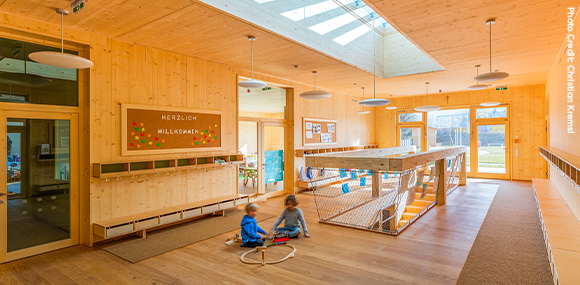
Think Wood broadened the reach of a new report from Seattle-based multidisciplinary design firm Mithun that explores the biophilic, climate, and health benefits of mass timber schools. The report sought to answer questions such as: How can we build schools that are adaptable and support student well-being and learning, and how do we cut carbon while delivering better schools faster and without breaking the bank?
As expertise and experience in mass timber continues to flourish across the country, an increasing number of designers are looking at how mass timber, combined with biophilic design, can help optimize learning environments. To further investigate the feasibility of mass timber schools, the Mithun team took an iterative approach driven by an optimized three-ply mass timber structural grid and sectional framework that balances efficient timber fiber volumes with the need for agile spaces. The report’s results demonstrate that mass timber spaces can be cost competitive for schools when compared with a steel-framed baseline—while also providing warm, well-daylit interiors and significantly reducing embodied carbon impacts.
Mass timber is proving to be cost competitive, according to Mithun’s analysis. Mass timber can increase the speed of construction and delivery by approximately 25%, taking advantage of faster, more efficient off-site prefabrication. For example, a study of 100 mass timber buildings in the U.K. showed an 80% reduction in truck deliveries and a 50-70% reduction in site staff needed for structural framing. In some markets, mass timber schools may show higher upfront costs compared with steel and concrete; however, the benefits of mass timber—including shorter construction schedules, reduced labor costs, reduced embodied carbon, increased student and staff productivity, and improved overall well-being—can offset and outweigh any initial premium, making mass timber the optimal choice.
Many school districts across the country are working to improve their school infrastructure, either by replacing aging structures or building new structures to accommodate population growth, or a combination. Building the case for mass timber as being particularly well suited for education environments can help unlock new demand and market share in this important sector.
WoodWorks’ Project Tours Create New Conversion Leads
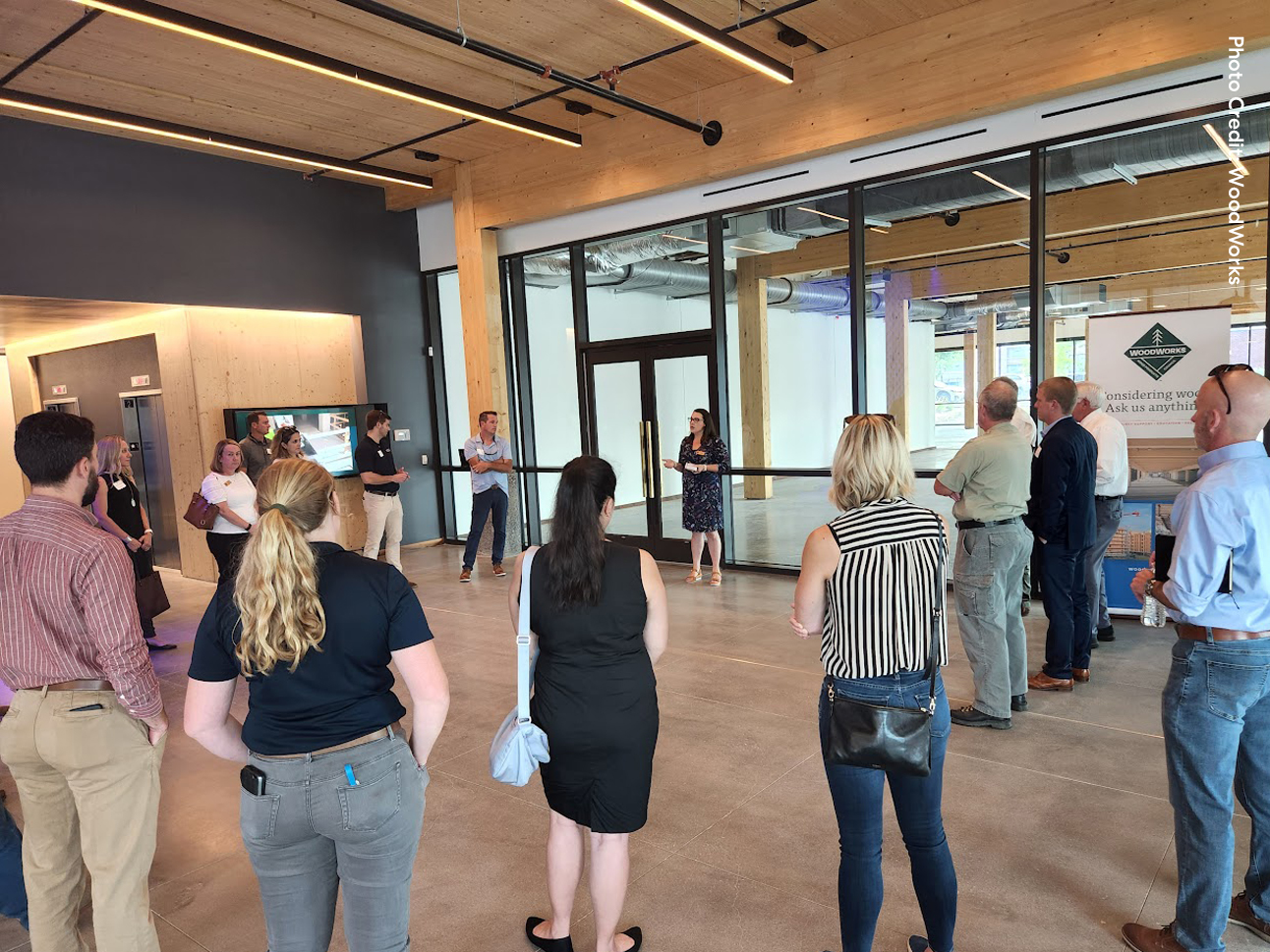
WoodWorks is finding great success in new conversion leads by facilitating learning tours of existing wood building projects to boost knowledge and interest in wood design and construction. After these tours, developers, architects, contractors, and government officials have expressed interest in using wood in future projects and have reached out to WoodWorks for further information and even project assistance. WoodWorks recently hosted tours of:
- 1030 Music Row, a five-story DLT and glulam office project in Nashville, Tennessee, for 21 attendees, including owner/developers, architecture and engineering professionals, and state government representatives. During the tour, the project architect credited WoodWorks with inspiring the company’s use of wood, which it has since replicated in two other mass timber buildings in design. The tour led to ongoing discussions with Tennessee government officials regarding active projects with the potential for mass timber, approaches to incorporating mass timber into state construction, and a potential carbon registry. WoodWorks is planning another tour of the project for Tennessee’s Division of Forestry, the Commissioner of General Services, and the Mayor of Nashville.
- The Annex in Portland, Oregon, a mass timber hybrid structure that demonstrates wood’s viability for sustainable affordable housing. One developer on the tour cited the tour’s information and discussions on financing as particularly useful; equipped with this knowledge, the developer is now eager to pursue similar work.
- 80M, an innovative three-story vertical expansion of an existing concrete/steel building in Washington, D.C., for 44 AEC professionals and government officials. Following the tour, multiple participating developers, architects, contractors, and government officials have contacted WoodWorks to request project assistance, lunch-and-learns, and/or insights on how to increase their mass timber expertise.
Upcoming mass timber building tours include Bowdoin College’s Mills Hall and the Center for Arctic Studies in Brunswick, Maine; the first modern mass timber office building in Baltimore, Maryland; and the DCAMM Department of Unemployment Assistance facility in Brockton, Massachusetts.
Industry News
New Home Listings Plummet Amid Declining Demand
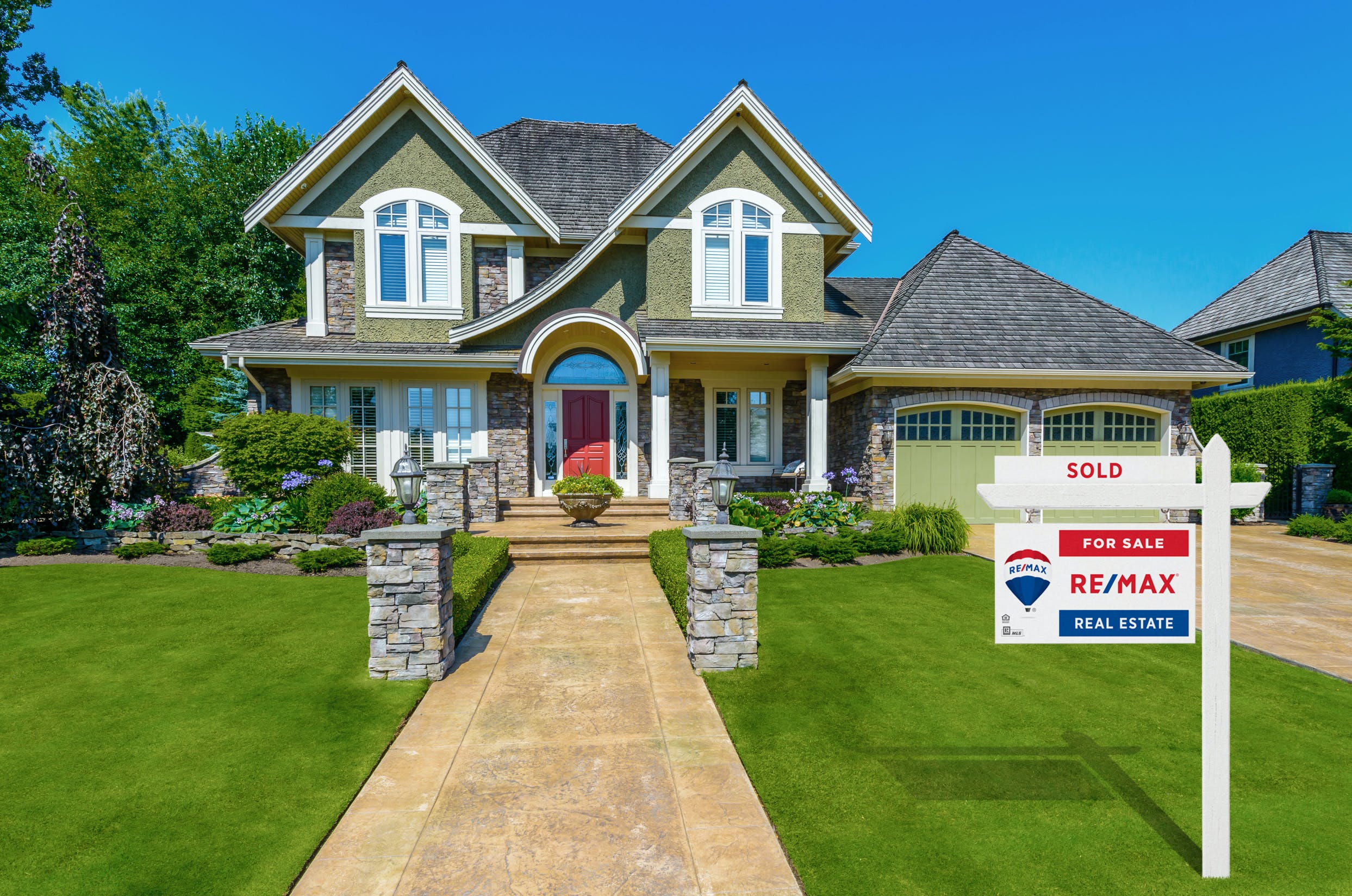
Based on data from Redfin, Yahoo! Finance is reporting that new home listings fell 15% over a four-week period from late July to late August. This decline is the largest annual drop since the start of the coronavirus pandemic and attributable to a combination of reduced demand and falling prices. Nationally, the median asking price of newly listed homes is 5% lower now than in May. Similarly, the national median sales price is 6% lower now than it was in June. This data dovetails with the Mortgage Bankers Association’s Weekly Mortgage Applications Survey results, which indicate declining numbers of mortgage applications.
According to Redfin Economics Research Lead Chen Zhao, “Sellers are coming to terms with the fact that volatile mortgage rates have dampened demand. Some sellers are pricing lower, and some homeowners are staying put because they’re nervous they won’t get a good offer or they’re hesitant to give up their low mortgage rate.” Redfin believes interested buyers still exist, but sellers will need to price fairly to attract them.
Meanwhile in Bloomberg, Goldman Sachs analysts warned that the U.S. housing market still has “further to fall” in terms of slowing home price growth and decreasing demand from prospective homebuyers, underpinned at least in part by higher mortgage rates. Goldman’s analysts believe that “the sustained reduction in affordability, waning pandemic tailwind, and recent decline in purchasing intentions all point to weakening home sales.” Other research data points to the trend that the median sale price for new homes in the U.S. is nearly double what it was 10 years ago.
New Mass Timber Tower Planned in Chicago
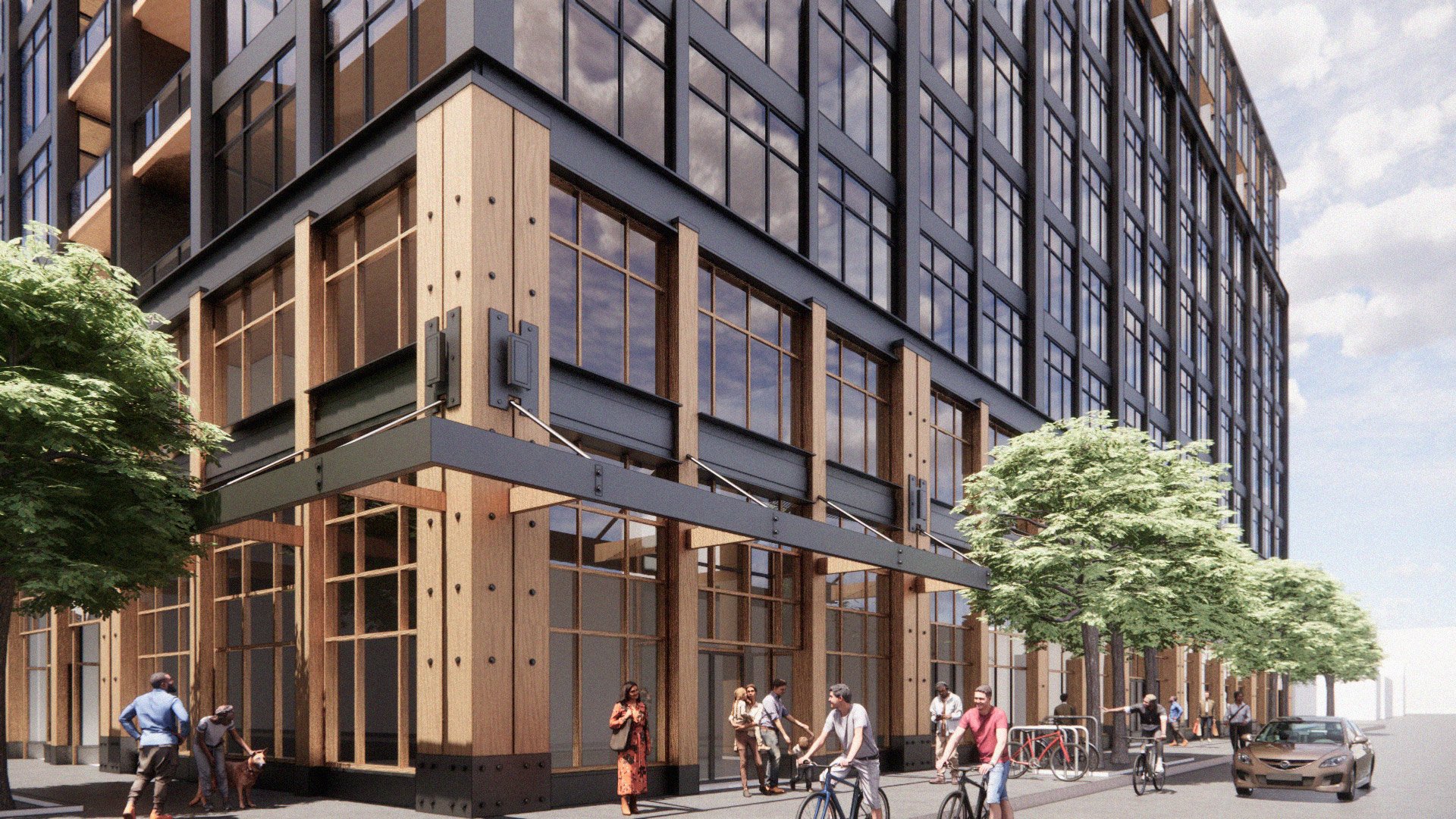
Dezeen is reporting that Hartshorne Plunkard Architecture (HPA), in partnership with Sterling Bay developers, has announced plans for a new, 119-foot tall, nine-story mass timber residential tower at 2100 N. Southport Avenue in Chicago’s Lincoln Park neighborhood. The building will consist of glued-laminated timber beams and columns and CLT floor assemblies, with a reinforced concrete stair core and parking enclosure. The project team was drawn to mass timber specifically as a means to maximize efficiency and minimize waste.
WoodWorks provided technical support to the HPA team along the way, including information on mass timber’s fire performance, adhesive qualifications, manufacturers, certification, testing data, and related topics. Chicago has historically been slow to accept timber construction, likely a legacy of the devastating Great Chicago Fire of 1871, so WoodWorks’ inputs purposely went to great lengths to help HPA demonstrate wood’s overall performance and safety.
The Chicago building department has approved the building design, and pending a final zoning change and council approval, construction is expected to begin in 2023. If completed as planned, the building will reportedly be the tallest timber building constructed in Chicago since before 1871.
In discussing the project, Sterling Bay CEO Andy Gloor noted, “Mass timber buildings are safe, sustainable, and beautiful, and we are excited to lead Chicago’s real estate community in working with this innovative building material at 2100 N. Southport.”
Read more about the project here.
New Mass Timber Building in Portland Pushes Sustainability to New Levels
ZGF Architects has completed the ultra-sustainable, five-story, 58,000-square-foot PAE Living Building in Portland, Oregon. Undertaken in partnership with Downtown Development Group, Edelen & Co., Walsh Construction Co., Apex Real Estate Partners, and engineering firm PAE, the project aims to demonstrate how to scale mass timber, reduce the carbon footprint of commercial buildings, and create a highly sustainable building that is profitable.
The building, which was constructed using CLT, glued-laminated timber, and concrete, has achieved these goals and is on track to become the first building in Portland to receive full certification from the International Living Future Institute under its rigorous Living Building Challenge program. The certification, which is expected in 2023, signifies that the building produces more energy than it consumes. Only 25 projects have received this exclusive certification since the program started in 2006.
According to ZGF, “The wood framing serves triple duty in this building—It holds the building up, serves as a final finish on the interior, and reduces the project’s embodied emissions by 30%.”
Based on the design and specification decisions, the project team believes that the building’s useful life will extend up to 500 years.
Read more about the project here.
New Study Builds Case for Timber Cities as Key Climate Solution
The online publication Engineering & Technology (E&T) and the online edition of The Hill newspaper recently covered how substituting timber in place of concrete in construction can create significant carbon savings. Both outlets cite a new comparative study from the Potsdam Institute for Climate Impact Research, which suggests that more than 100 billion tons of carbon emissions could be avoided by 2100 if housing construction used timber instead of steel and concrete, particularly in cities.
The study calls for the establishment of new, sustainably managed working forests to ensure an adequate supply of wood products for use in construction, in addition to ongoing harvest from natural forests. The study asserts that most of the additional 345 million acres needed for wood production could be sourced from forestland already being harvested for timber, avoiding negative secondary impacts on food systems.
Currently, more than half of the world’s population lives in cities, and this is expected to rise to upward of 85% by 2100. According to the lead study author, Abhijeet Mishra, “This means more homes will be built with steel and concrete, most of which have a serious carbon footprint, … but we have an alternative: We can house the new urban population in mid-rise buildings made out of wood.”
Mishra notes that producing mass timber releases considerably less CO2 than producing steel and cement. In addition, because of wood products’ carbon-storage ability, cities themselves can turn into carbon sinks and thus “play a vital role in climate change mitigation.”
The Hill goes on to provide examples of recent projects around the world that are already demonstrating the role of timber in modern urban development, including the 25-story hybrid Ascent residential tower in Milwaukee, Wisconsin; the 280-foot-tall, all-wood tower Mjøstårnet in Norway; and the five-story, highly efficient PAE Living Building in Portland, Oregon, which was designed to last for 500 years. The Hill also gives nods to mass timber’s fire performance, as demonstrated by U.S. Forest Service Forest Products Lab testing, and its biophilic qualities, all of which add to its overall package of benefits in future urban development.
Read the full study here.
Multifamily, For-Rent Housing Starts Climb to 36-Year High
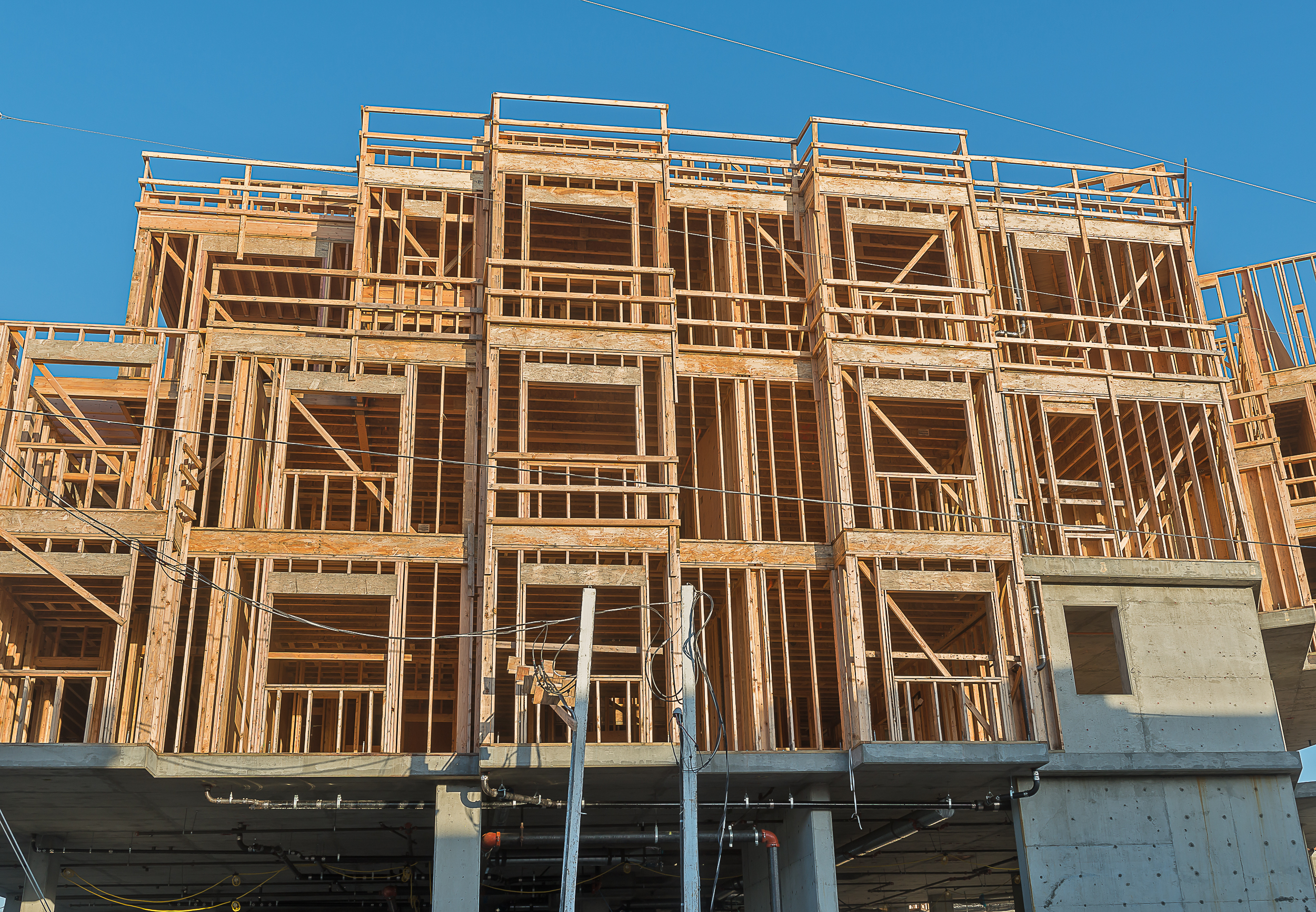
Multifamily, for-rent housing starts climbed to a 36-year high in Q2 2022. According to data and analysis from the U.S. Census Bureau and the National Association of Home Builders (NAHB), 142,000 multifamily, for-rent housing units were started in Q2, the most productive quarter for the segment since Q2 1986.
Rental’s share of the multifamily segment has swung dramatically over the years, plummeting from a 22-year average of 80% down to 47% in Q3 2005, and now back up to 96%. The multifamily rental market tends to move in an opposing direction from the condominium market—condominium construction was surging in 2005 when multifamily rental hit its low; meanwhile, in Q2 2022, only 7,000 multifamily condominium construction starts were recorded while multifamily rental surged.
Read more about these trends here.
Insights on the Competition
Concrete Industry See Opportunities in New Federal Climate Bill
Online business and ESG platform ImpactAlpha recently explored how the new federal inflation reduction/climate change package offers new incentives to decarbonize construction. The concrete industry joins the wood products industry in seeing distinct opportunities to position their products in the government’s new efforts to use low-carbon materials in public infrastructure and government buildings. In addition, concrete sees opportunities via new spending to spur resilience in affordable housing and a new tax credit for retrofitting manufacturing facilities to emit at least 20% less carbon.
ImpactAlpha believes that this new federal spending will accelerate and complement ongoing private-sector and local efforts to develop low-carbon cement. Technology wise, ongoing efforts include CarbonCure, which has to date reduced more than 200,000 tons of CO2 emissions and has been specified by Amazon for its new secondary headquarters under development in Arlington, Virginia. ImpactAlpha also cites Brimstone Energy, which is using calcium silicate instead of limestone to make a cement that is of comparable quality and price, and TerraCO2, which is similarly working to replace limestone in cement production, this time with silicate rocks.
ImpactAlpha also notes ongoing efforts to decarbonize concrete at local and state levels and via associations of producers. For example, an initiative backed by local governments in Colorado, Arizona, New Mexico, and Utah is providing catalytic grants to local projects that link CO2 removal and storage to concrete. Meanwhile, New York and New Jersey are using their purchasing power to promote the use of low-carbon concrete in public projects.
As noted by Jen Carson of Climate Group, an environmental services firm, an important missing piece for the concrete industry as it works to innovate lower-carbon cement is “independent global certification and verification” that ensures transparency and data quality.
Read more about these efforts here.
Industry Resources
FEA’s Housing Dashboard
View the September Dashboard
Virginia Tech's Monthly Housing Report
This monthly housing commentary report is a free service of Virginia Tech and is intended to help one gauge future business activity in the U.S. housing market.
July 2022 Reports (released in September 2022)
Part A: July Housing Commentary
Part B: July Economic Conditions


